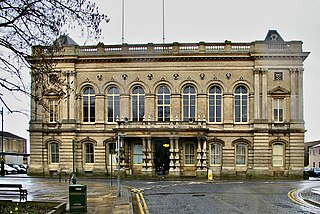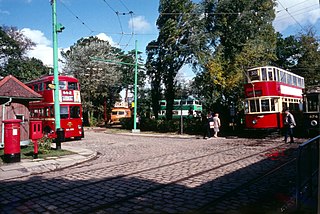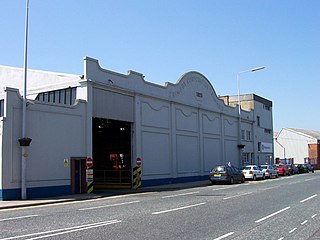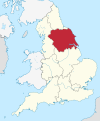
North East Lincolnshire is a unitary authority area with borough status in Lincolnshire, England. It borders the borough of North Lincolnshire and districts of West Lindsey and East Lindsey. The population of the district in the 2011 Census was 159,616. The administrative centre and largest settlement is Grimsby and the borough includes the towns of Cleethorpes and Immingham as well as the villages of New Waltham, Waltham, Humberston, Healing and Great Coates. The borough is also home to the Port of Grimsby and Port of Immingham as well as Cleethorpes beach.

Cleethorpes is a seaside town on the estuary of the Humber in North East Lincolnshire, Lincolnshire, England with a population of 38,372 in 2020. It has been permanently occupied since the 6th century, with fishing as its original industry, then developing into a resort in the 19th century. Before becoming a unified town, Cleethorpes was made up of the three small villages of Itterby, Oole and Thrunscoe.

Grimsby or Great Grimsby is a port town and the administrative centre of North East Lincolnshire, Lincolnshire, England. Grimsby adjoins the town of Cleethorpes directly to the south-east forming a conurbation. Grimsby is 45 mi (72 km) north-east of Lincoln, 33 mi (53 km) south-south-east of Hull, 28 mi (45 km) south-east of Scunthorpe, 50 mi (80 km) east of Doncaster and 80 mi (130 km) south-east of Leeds. In 2021 it had a population of 86,138.

Reading Transport Limited, trading as Reading Buses, is an English municipal bus operator owned by Reading Borough Council, serving the towns of Reading, Bracknell, Newbury, Slough, Windsor, Maidenhead, Wokingham and the surrounding areas in the counties of Berkshire, Oxfordshire, Surrey and Hampshire, as well as parts of Greater London.

The East Anglia Transport Museum is an open-air transport museum, with numerous historic public transport vehicles. It is located in Carlton Colville a suburb of Lowestoft, Suffolk. It is the only museum in the country where visitors can ride on buses, trams and trolleybuses, as well as a narrow-gauge railway.
Lincolnshire is a large county in England with a sparse population distribution, which leads to problems funding all sorts of transport. The transport history is long and varied, with much of the road network still based on the Roman model, and the once extensive rail network a shadow of its former self.

Stagecoach in Hull is a bus operator providing services in Kingston upon Hull, East Riding of Yorkshire, England. It is a subsidiary of Stagecoach East Midlands, a subdivision of the Stagecoach Group.

Stagecoach Lincolnshire is a bus company, formerly known as Lincolnshire RoadCar, operating bus services throughout Lincolnshire. The company is a division of Stagecoach East Midlands, which is a subsidiary of the Stagecoach Group.

Cleethorpes railway station is a railway station serving the seaside town of Cleethorpes in Lincolnshire, England. The station is managed by TransPennine Express, with East Midlands Railway and Northern Services also using the station. The station is the terminus and start of multiple services.

Nottingham City Transport (NCT) is the major bus operator of the city of Nottingham, England. NCT operates extensively within Nottingham as well beyond the city boundaries into Nottinghamshire county. Publicly-owned, it is today the second largest municipal bus company in the United Kingdom after Lothian Buses in Edinburgh, Scotland.

The Grimsby & Immingham Electric Railway (G&IER) was an electric light railway, primarily for passenger traffic, linking Great Grimsby with the Port of Immingham in Lincolnshire, England. The line was built by the Great Central Railway (GCR), was absorbed by the London & North Eastern Railway (LNER) in 1923, and became part of the Eastern Region of British Railways. It ran mainly on reserved track.

The Kingston upon Hull tramway network was a network of 4 ft 8+1⁄2 instandard gauge tram lines following the five main roads radially out of the city centre of Kingston upon Hull, East Riding of Yorkshire, England. Two of these lines went west, and two east. The fifth went to the north, and branched to include extra lines serving suburban areas. Additionally a short line linked the city centre to the Corporation Pier where a ferry crossed the Humber Estuary to New Holland, Lincolnshire.

Stagecoach East Midlands is a bus operator providing local and regional services across the East Midlands, the city of Kingston upon Hull and Lincolnshire. The company is a subsidiary of the Stagecoach Group.

The Walsall trolleybus system once served the town of Walsall, then in Staffordshire, but now in West Midlands, England. Opened on 22 July 1931, it gradually replaced the Walsall Corporation Tramways network.

The Grimsby trolleybus system once served the seaport of Grimsby, in Lincolnshire, England. Opened on 3 October 1926, it gradually replaced part of the Great Grimsby Street Tramways, a tramway that had served both Grimsby and the neighbouring holiday resort of Cleethorpes. It was closed on 4 June 1960.

The Cleethorpes trolleybus system once served the holiday resort of Cleethorpes, in Lincolnshire, England. Opened on 18 July 1937, it replaced part of the Great Grimsby Street Tramways, a tramway that had served both Cleethorpes and the neighbouring seaport of Grimsby. It was closed on 4 June 1960.

Lincolnshire InterConnect is a rural bus network in the county of Lincolnshire in the east of England.

Buses in Ipswich operate in the town of Ipswich in the English county of Suffolk. As of 2013 services are primarily operated by Ipswich Buses and First Norfolk & Suffolk, although other smaller operators, such as Galloway European, Carters Coaches and Beestons, operate routes from the town into the surrounding rural area. Many of the current routes are based on those established at the end of the 19th century when a horse tram network developed.

The Great Grimsby Street Tramways Company was a tramway serving Grimsby and Cleethorpes in Lincolnshire, England. It was a subsidiary of The Provincial Tramways Company. They opened a horse tramway in 1881, running from the Wheatsheaf Inn in Bargate to the border with Cleethorpes, with a branch along Freeman Street, and extended the line into Cleethorpes in 1887. It followed the trend of many British systems, and was converted to an electric tramway in December 1901. Small extensions were made to the system at both ends, but the basic plan of the system remained the same throughout its life.
Bradford Corporation Tramways were a tramway network in the city of Bradford, West Riding of Yorkshire, England which operated trams from 1882 until 1950 and trolleybuses from 1911 until 1972. The track gauge of the tramways was 4 ft.





















